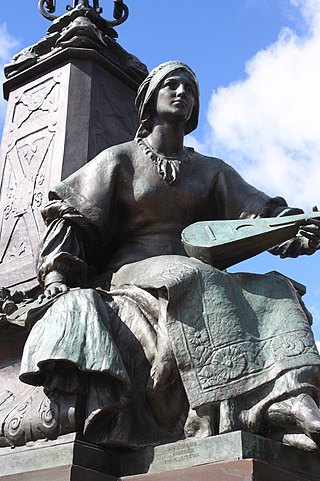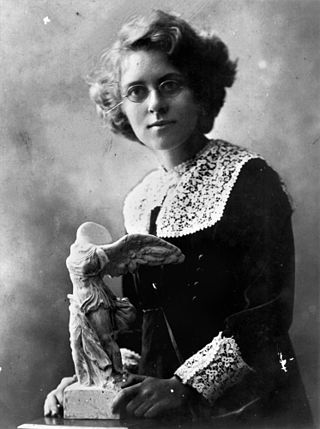
Lee Oscar Lawrie was an American architectural sculptor and an important figure in the American sculpture scene preceding World War II. Over his long career of more than 300 commissions Lawrie's style evolved through Modern Gothic, to Beaux-Arts, Classicism, and, finally, into Moderne or Art Deco.

Hyde Park, Sydney, is an urban park, of 16.2-hectare (40-acre), located in the central business district of Sydney, in the City of Sydney local government area of New South Wales, Australia. It is the oldest public parkland in Australia. Hyde Park is on the eastern fringe of the Sydney city centre and is approximately rectangular in shape, being squared at the southern end and rounded at the northern end. It is bordered on the west by Elizabeth Street, on the east by College Street, on the north by St James Road and Prince Albert Road and on the south by Liverpool Street.

The Australian War Memorial (AWM) is a national war memorial and museum dedicated to all Australians who died during war. The AWM is located in Campbell, a suburb of the Australian capital of Canberra. The grounds include five buildings and a sculpture garden. Most of the museum galleries and commemorative areas are contained in the Memorial Building.

The Anzac Memorial is a heritage-listed war memorial, museum and monument located in Hyde Park South near Liverpool Street in the CBD of Sydney, Australia. The Art Deco monument was designed by C. Bruce Dellit, with the exterior adorned with monumental figural reliefs and sculptures by Rayner Hoff, and built from 1932 to 1934 by Kell & Rigby. This state-owned property was added to the New South Wales State Heritage Register on 23 April 2010.
Arthur James Murch was an Australian artist who won the Archibald Prize in 1949 with a portrait of Bonar Dunlop. Dunlop was a New Zealand artist sculptor and illustrator.

Charles Bruce Dellit was an Australian architect who pioneered the Art Deco style in Australia. He was generally known as Bruce Dellit.

Sir Edgar Bertram Mackennal, usually known as Bertram Mackennal, was an Australian sculptor and medallist, most famous for designing the coinage and stamps bearing the likeness of George V. He signed his work "BM".

Paul Raphael Montford was an English-born sculptor, also active in Australia; winner of the gold medal of the Royal Society of British Sculptors in 1934.

The Sydney Cenotaph is a heritage-listed monument located in Martin Place, in Sydney, New South Wales, Australia. It was designed by Bertram Mackennal and built from 1927 to 1929 by Dorman Long & Co. It is also known as Martin Place Memorial and The Cenotaph. It is one of the oldest World War I monuments in central Sydney. It was added to the New South Wales State Heritage Register on 11 November 2009.

The National War Memorial (South Australia) is a monument on the north edge of the city centre of Adelaide, South Australia that commemorates South Australians who served in the First World War and those who gave their lives. It was opened in 1931. The memorial is on the corner of North Terrace and Kintore Avenue, next to the grounds of Government House. Observances are held at the site throughout the year, with major services on Anzac Day (25 April) and Remembrance Day (11 November).

Lilian Daphne Mayo was an Australian artist, most prominently known for her work in sculpture, particularly the tympanum of Brisbane City Hall and the Women's War Memorial in ANZAC Square.

Emil Lawrence Sodersten was an Australian architect active in the second quarter of the 20th century. His work encompassed the Australian architectural styles of Art Deco and Functionalist & Moderne. His design for the Australian War Memorial was "the first national architectural monument in Australia". The Australian Institute of Architects presents the Emil Sodersten Interior Architecture Award annually in his honour.
Gilbert William Bayes was an English sculptor. His art works varied in scale from medals to large architectural clocks, monuments and equestrian statues and he was also a designer of some note, creating chess pieces, mirrors and cabinets.

William Leslie Bowles, commonly referred to as Leslie Bowles or W. Leslie Bowles, was an Australian sculptor and medallist.

Yininmadyemi - Thou didst let fall is a sculptural artwork by Indigenous Australian artist Tony Albert located in Hyde Park, Sydney. Unveiled on 31 March 2015, the artwork acknowledges the service of Aboriginal and Torres Strait Islander men and women in the Australian Defence Force.

The Egyptian Room, Royal Arch Masonic Temple is a heritage-listed Masonic Lodge meeting room at 23-35 New Canterbury Road, Petersham, Inner West Council, Sydney, New South Wales, Australia. It was designed by A. Phipps Coles. Originally built in 1927 for the Scottish Royal Arch Temple in College Street, Sydney, it was re-erected in 1977 at the Royal Arch Temple in Petersham. Craftsmen who worked on the room included Rayner Hoff (sculptor), Charles Everett (decoration) and G. R. Lumb and Sons. It was added to the New South Wales State Heritage Register on 2 April 1999.

The Paragon Cafe is a heritage-listed restaurant located at 65 Katoomba Street, Katoomba, New South Wales, Australia. It was designed in successive stages by Harry & Ernest Sidgreaves shopfitters, architects Harry Lindsay Blackwood and George Newton Kenworthy, with decoration by Otto Steen, and built from 1909 to 1940. It is also known as Paragon Restaurant or simply The Paragon. It was added to the New South Wales State Heritage Register on 5 March 2015.
Barbara Tribe (1913–2000) was an Australian-born artist who spent most of her career in Cornwall. She is regarded as a significant twentieth-century portrait artist, working both in painting and sculpture.

Orlando Henry Dutton was an English-born Australian monumental, figurative and architectural sculptor.
Lyndon Raymond Dadswell was an Australian artist, remembered as the country's first official war sculptor.























